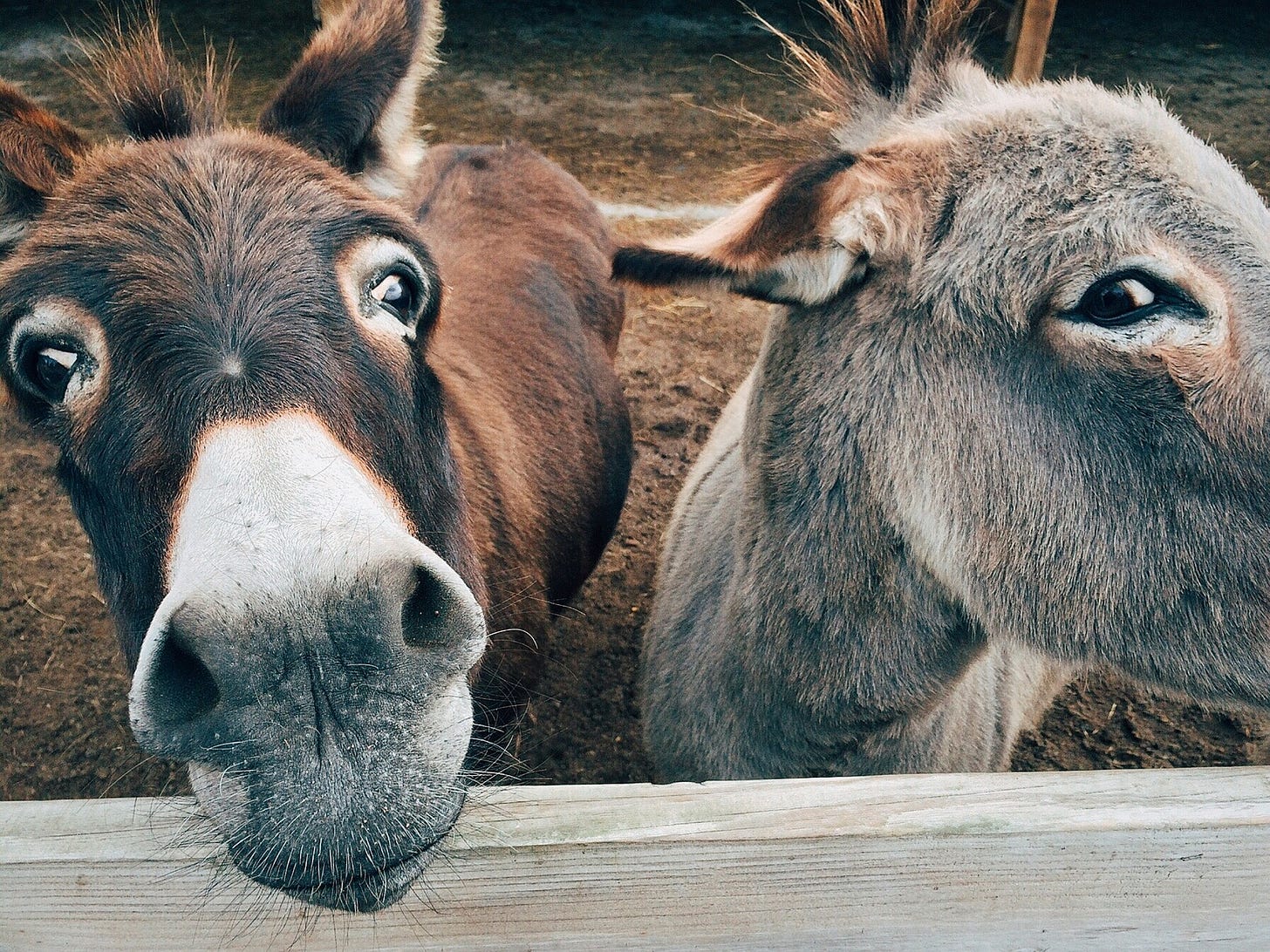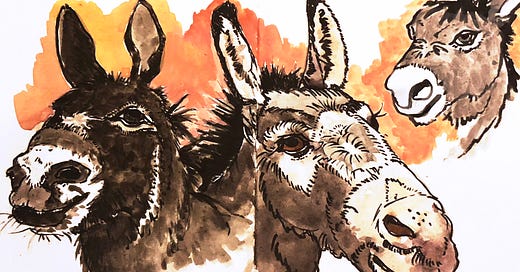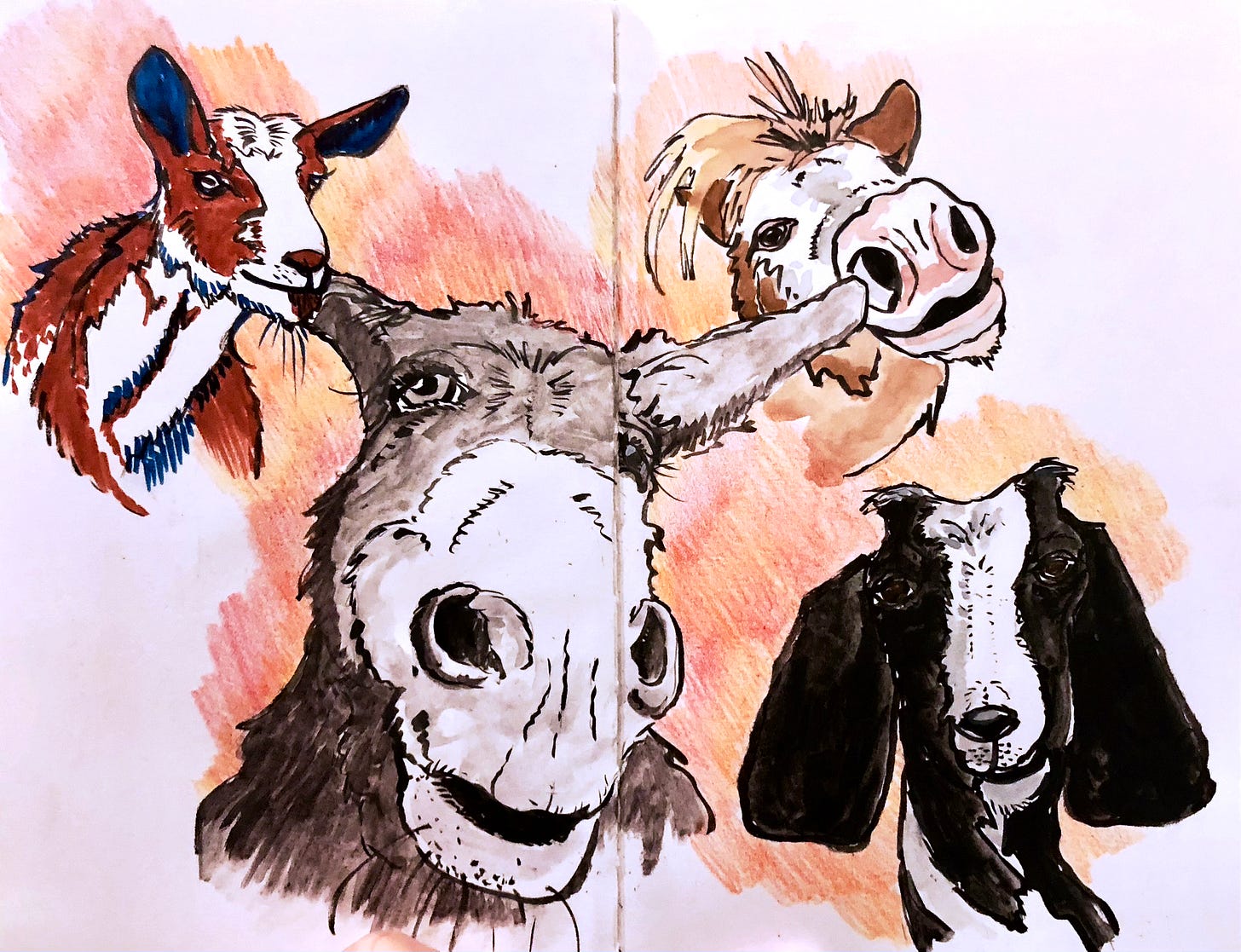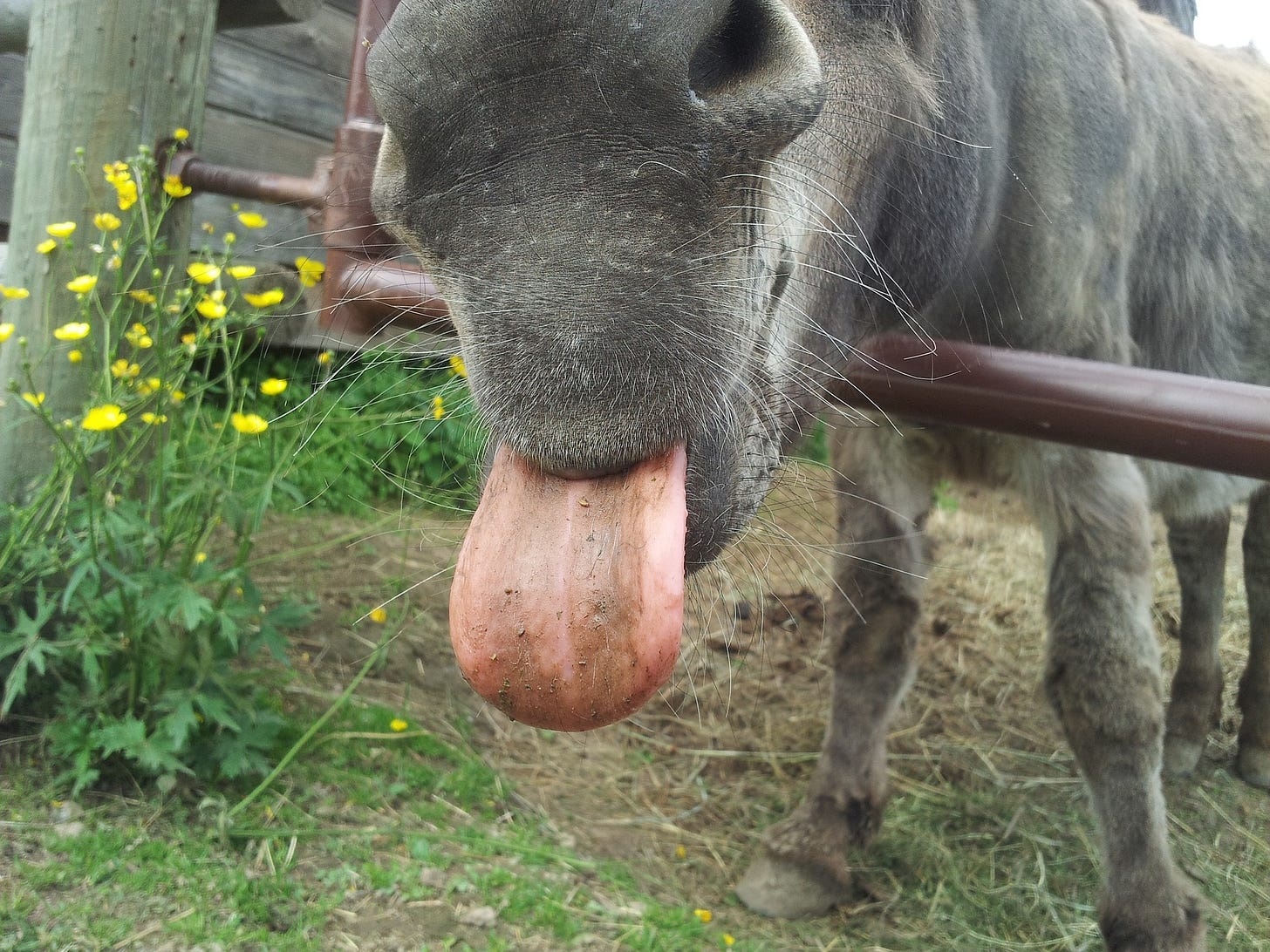If you liked reading this, feel free to click the ❤️ button on this post so more people can discover it on Substack 🙏
The 12 Days of Christmas are over, and Plough Monday ( the old festival on the Monday after Epiphany marking the return to work and winter plowing for agricultural workers) has also come and gone. But never fear; our Medieval ancestors had yet another feast day ready and waiting to make the long winter more bearable.
The Feast of the Ass comes around each year on January 14th to commemorate the Holy Families Flight into Egypt.
There has been a lot written and speculated about what happened to the Holy Family on their way to Egypt to escape the murderous King Herod and what influence Egyptian wisdom may have had on the young Jesus until the time God called his Son out of Egypt.
Given all of that, the fact that the Medieval imagination landed on the image of the donkey with enough fervor to create an entire feast day honoring and recognizing not only the donkey that carried Mary and Jesus into Egypt but all of the donkeys in the Bible is just too good and makes me laugh.
Personally, I love donkeys (mules, too). I have nothing against horses; they’re beautiful, very sensitive, and possibly psychic. Donkeys, on the other hand, are grounded, patient, sturdy, long-suffering, and, in my experience, have a good sense of humor. I find them far more calming to be around than horses.
So what about this Feast of the Ass?
This peculiar festival seems to have grown from the Medieval Feast of Fools held on January 1st. The Feast of Fools belongs to a type of celebration in which the established social or ecclesiastical order is turned on its head, mocked, and ridiculed.
The festival seems to have acted as a brief social revolution in which power, dignity, and impunity were briefly granted to those in a subordinate position. Lower-level clergy would participate in the festival and hold masses on different days, which would mock church traditions.
On each day of festivities, the participants would elect…the Archbishop of Fools, and they would carry and wear the items associated with that rank, in addition to gaining the powers normally associated with that position. The meaning of the festival, beyond serving as a chance for joy like any other holiday, was to show that those with power and wealth would eventually fall from grace. ~ Wikipedia
Institutions become corrupt. Regardless of the mission they are founded upon institutions by their very nature, amass and centralize power, and with power inevitably comes corruption. There was plenty of corruption in the Medieval Church, just as there is in our own institutions. The United Nations, The Red Cross, the WHO, and our own governments suffer from corruption; they do good as well as evil, and so it was with the Medieval church. The Feast of Fools seems to have been a time for the peasantry to express their grievances with the obvious corruption in the Church through mockery.
As you might imagine, the Church took a dim view of this subversive festival. Over time (and it took a long time), the Feast of the Ass eventually replaced the Feast of Fools.
However, something of the original intent remained in the Feast of the Ass. Customs varied from place to place, and I will highlight a few elements that stand out.
The feast itself seems to have been a type of procession and pageant, like an old-fashioned Christmas pageant. A young woman and a child would ride on a donkey and process through the town to the church. They would enter the church, and the donkey would stand beside the altar as the sermon was preached. Something you're not likely to see any time soon in your local church.

In some places, there’s a sort of play in which the clergy takes on the parts of the ancient Hebrew prophets, Virgil the Roman poet, Nebuchadnezzar the Babylonian King, and the Erythraean Sibyl the prophetess of classical antiquity from the oracle of Apollo at Erythrae, who marshall an effort to convince the unbelieving Gentiles of the veracity of the Messiah.
Already, you can see why I love this. The inclusion of Virgil and the Sybil makes it a delicious blending of classical pre-Christian and Medieval Christian imagery, something I adore.
In other places like Rouen, France, a dramatized debate takes place. The parts played are for various Old and New Testament figures, including Balaam and his Donkey, pitted against three Gentile prophets. There are also instructions for a furnace with a blazing fire and a faux idol to be erected, which will be rejected by the faithful. The entire spectacle takes place under the auspices of someone playing the part of the venerable St. Augustine. At the end The Sibyl makes her pronouncement, and the proceedings come to a close. This must have been quite exciting for Medieval churchgoers.
Among the various customs in differing places, it seems that a favorite part of the entire performance was Balaam and his Donkey. This may account for how the Feast of the Ass came to be a separate festival all of its own.
For those not familiar with the story of Balaam and His Donkey, I will briefly tell it here…
Once, there was a man named Balaam, a seer and prophet, though not a Israelite. The enemies of the Israelites offer to pay Balaam to utter a curse against the Israelites. On his way to collect his payment an angel barrs his way. Balaam can’t see the angel but his donkey can and veres off the road. Balaam is annoyed, whips the donkey and they go a little further. The donkey then pushes against a wall to avoid the angel crushing Balaam’s foot in the process which gets the donkey another beating. Balaam tries to continue on the road but the donkey lays down and is then beaten severely by Balaam.
The angel angered by Balaam’s treatment of the donkey gives the donkey the power of speech. At this point the donkey asks “What have I done to you to make you beat me these three times?” Outraged Balaam cries, “You have made a fool of me! If only I had a sword in my hand I would kill you right now.”
The donkey further questions Balaam “Am I not your own donkey, which you have always ridden, to this day? Have I been in the habit of doing this to you?”
Then Balaam’s eyes are opened and he sees the angel in the road, sword drawn. The angel admonishes Balaam, asking why he beat his donkey heartlessly instead of realizing that his path was reckless.
It’s easy to see why this story would be a favorite. The powerful are wicked and blind, and Heaven takes the side of the lowly donkey who has always done his work faithfully. Plus who doesn't love a talking donkey? It’s not hard to imagine that Medieval people would have equated the higher level clergy with Balaam, powerful but spiritually blind and themselves with the faithful donkey, lowly but sincere in their faith. It’s also not hard to imagine that they would have drawn a comparison to the faithful donkey who was treated well by the Holy Family and carried them to safety and Balaam’s donkey who tries to keep his master safe but whose faithfulness goes unnoticed and unappreciated by Balaam.
Lest you think the festival is becoming too solemn things take a hilarious turn in a way that only the Medieval mind could take us.
At Beauvais, we find the the Ass in his customary role of carrying a young woman and child through the town and into the church to stand at the altar as the sermon is given.
But then a little song is sung in Latin with a French refrain which in English says…
From the Eastern lands, the Ass comes,
beautiful and brave, fit to bear burdens.
Up! Sir Ass, and sing.
Open your pretty mouth.
Hay will be yours in plenty, and oats in abundance.
At then end of the Mass the priest turns to the congregation and instead of intoning the 'Ite missa est' the words that dismiss the people, the priest brays three times like a donkey and the people instead of replying 'Deo Gratias', (thanks be to God) say 'Hinham, hinham, hinham’ the Medieval equivalent of Hee-Haw, Hee-Haw, Hee-Haw.
I find this whole scene absolutely hilarious and filled with earthy good humor and down-to-earth sarcasam.
The Feast of the Ass reminds us that the wealthy and powerful are often wicked and corrupt and deserved to be mocked and that ordinary folk and animals are often spiritually wise and favored by Heaven.
Share your donkey stories and your experiences with animals being messengers sent to you from above.
If you love donkeys, horses or animals in general do consider donating to Ray of Light Farm, East Haddam, CT a non-profit animal rescue I have personal experience with. Visit their website and Donate Here.
The comments section is a safe and welcoming space to share your insights and experiences.
Comments and conversation are always appreciated and enjoyed, so feel free to let your voice be heard. I read them all and try to respond to each one.
Thank you for reading Hedge Mystic and participating in this vibrant and growing community of creative, spiritual humans. You are always welcome here, appreciated, and loved.
One of the ways I am offering tangible support to fellow artists is through a new hybrid personal and group coaching program called The Mytho-Poetic Artist.
This will be beyond what some of you are ready for. However, it will be exactly what a few of you are looking for and ready to invest in right now.
I will only be accepting four artists who already have an active and ongoing creative practice. There will be personal coaching as well as community time with the other artists to exchange experiences and insights.
Our journey together begins February 1st.
If you’re intrigued by working personally with me and being part of a small, select group of kindred spirits and like-minded artists, click on the graphic below to access all of the details.










This was a wonderful telling, Jan! I love the sly humor woven throughout these festivals.
I so loved this! A glorious and Abundant New Year to You!